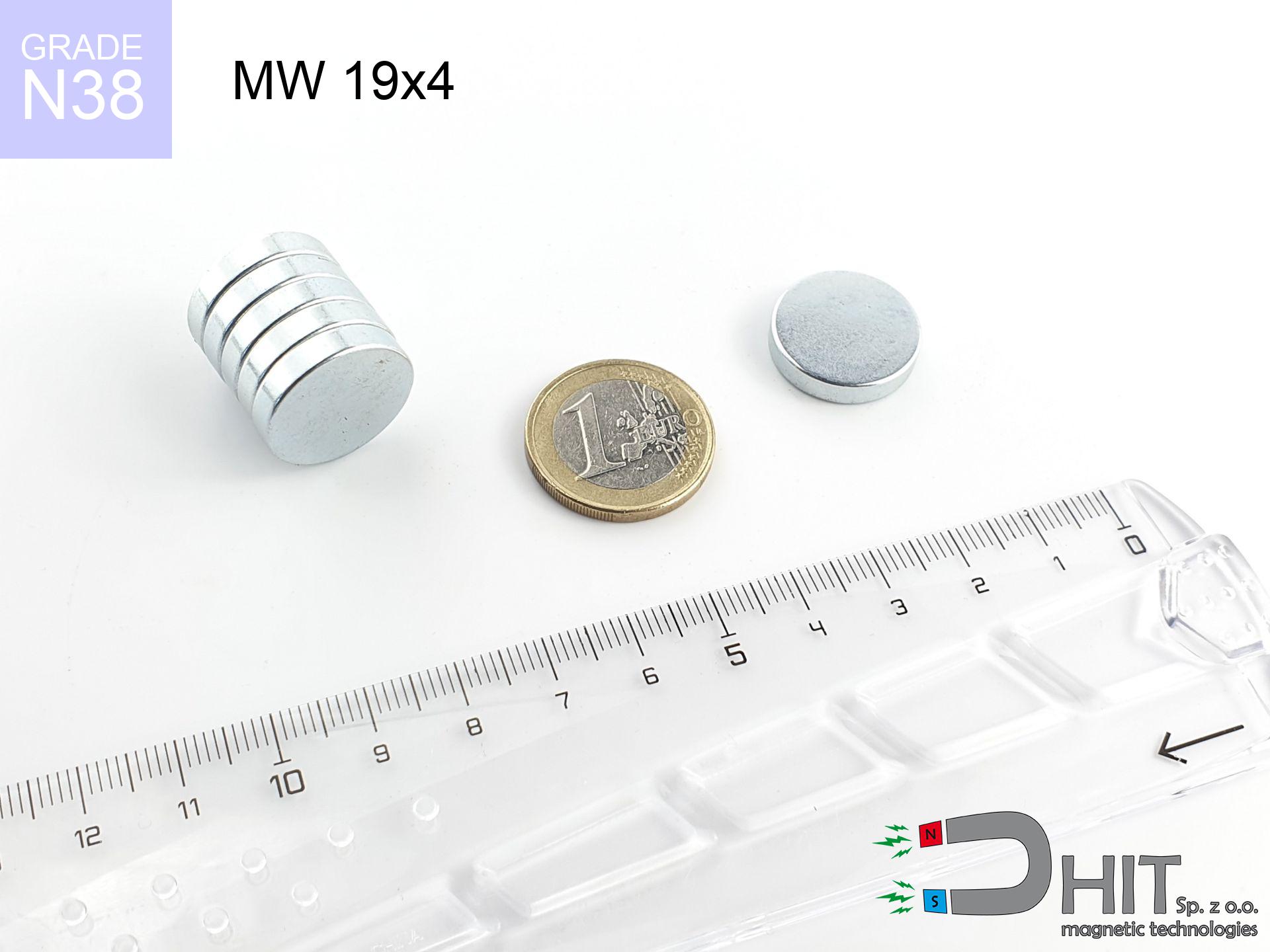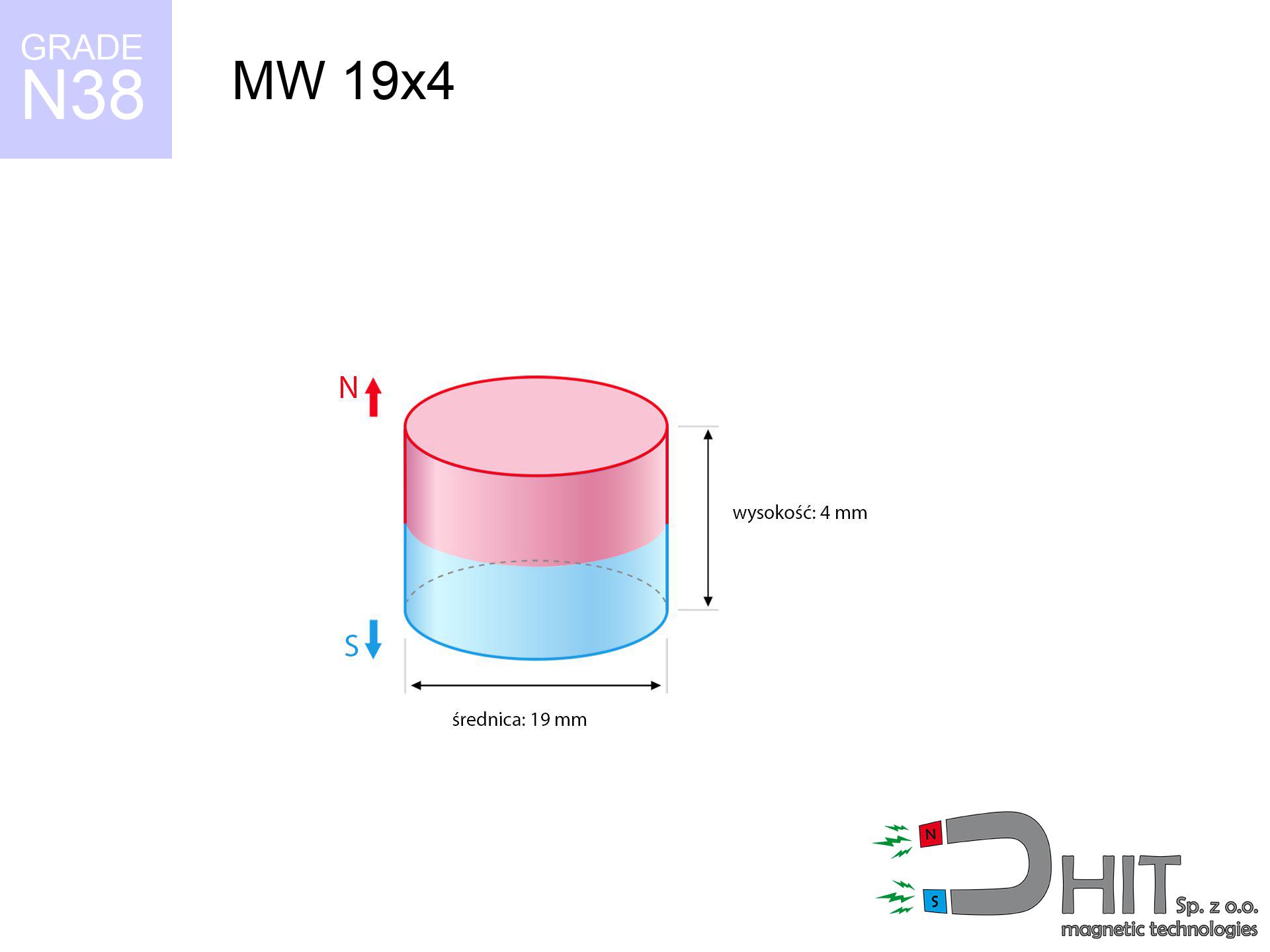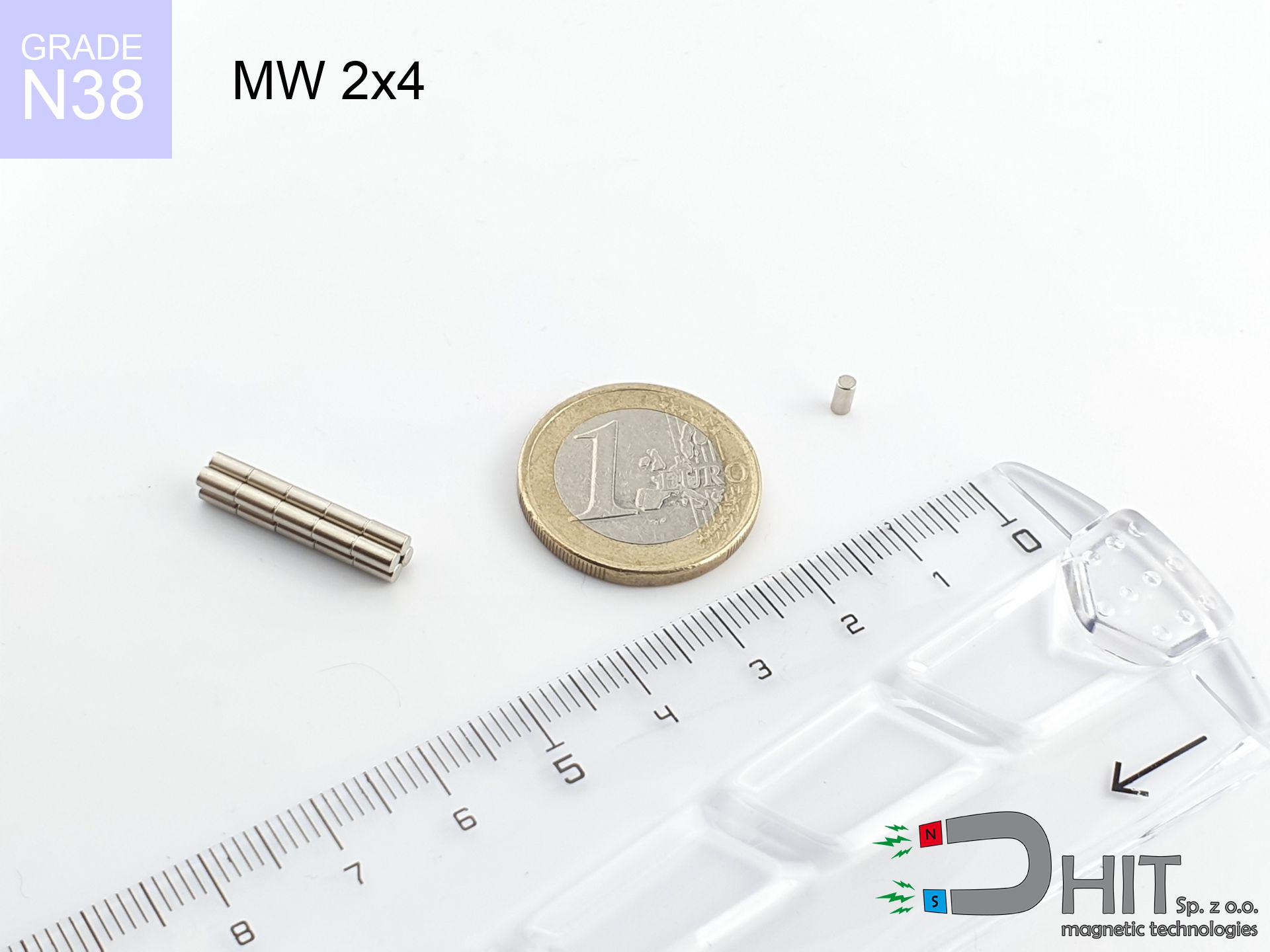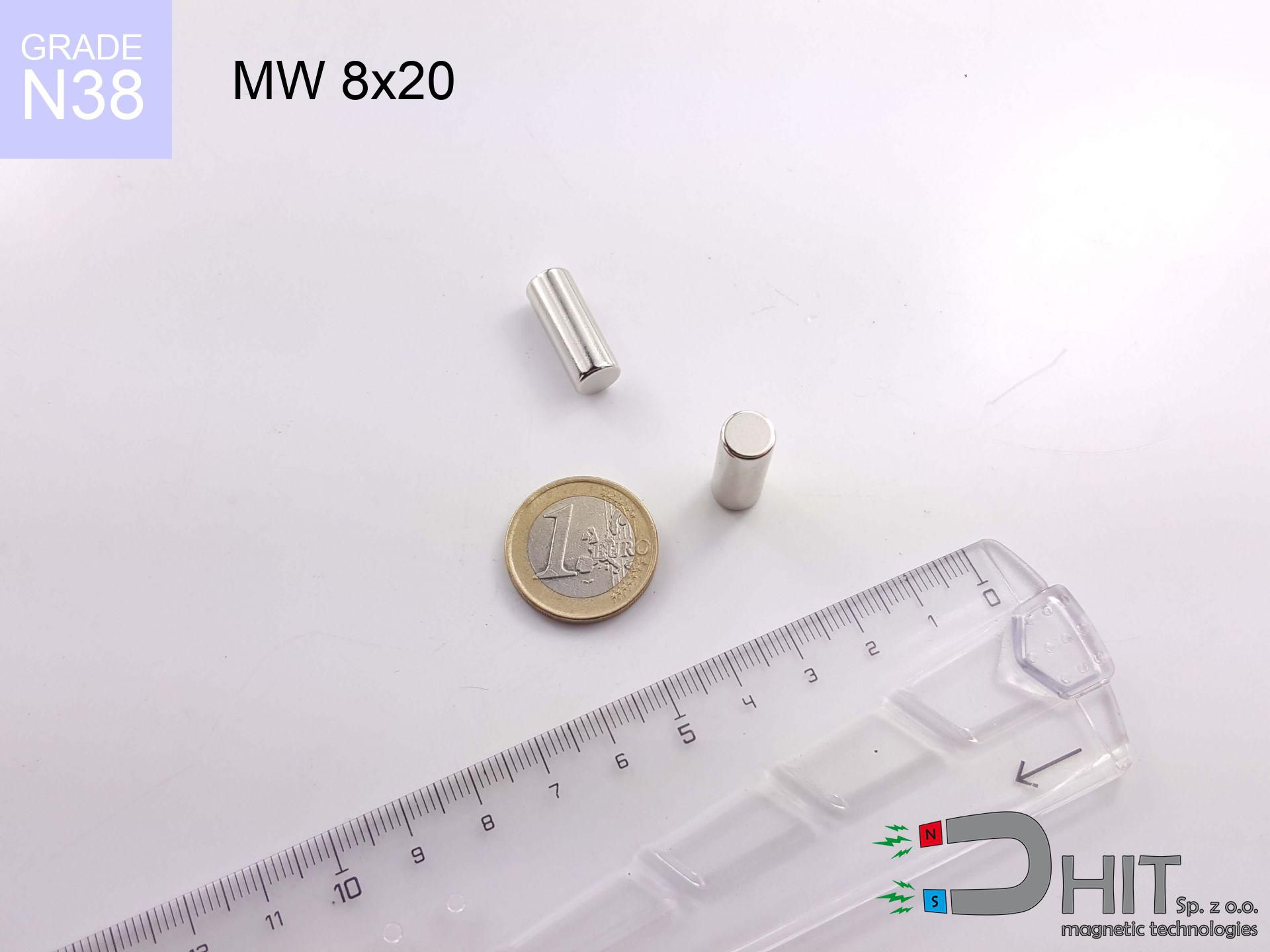MW 19x4 / N38 - neodymium magnet
cylindrical magnet
catalog number 010038
GTIN: 5906301810377
diameter Ø
19
mm [±0,1 mm]
height
4
mm [±0,1 mm]
magnetizing direction
↑ axial
capacity ~
4.20 kg / 41.19 N
magnetic induction ~
240.51 mT / 2,405 Gs
max. temperature
≤ 80
°C
catalog number 010038
GTIN: 5906301810377
diameter Ø
19 mm [±0,1 mm]
height
4 mm [±0,1 mm]
magnetizing direction
↑ axial
capacity ~
4.20 kg / 41.19 N
magnetic induction ~
240.51 mT / 2,405 Gs
max. temperature
≤ 80 °C
4.80 ZŁ gross price (including VAT) / pcs +
3.90 ZŁ net price + 23% VAT / pcs
bulk discounts:
need more quantity?Don't know what to choose?
Call us tel: +48 888 99 98 98 or get in touch through contact form on our website. You can check the mass as well as the appearance of neodymium magnets in our force calculator force calculator
Orders placed by 2:00 PM will be shipped on the same business day.
Specification: cylindrical magnet 19x4 / N38 ↑ axial
Magnetic properties of the material N38
Physical properties of sintered neodymium magnets Nd2Fe14B
Moreover, even though neodymium is a component of the strongest magnets, they are susceptible to corrosion in humid environments. Therefore, they are coated with a thin layer of gold-nickel to protect them from corrosion. Interestingly that NdFeB neodymium magnets are about 13% lighter than SmCo magnets and, despite their power, easily break, which requires special caution during their handling. For this reason, any mechanical processing should be done before they are magnetized.
In terms of safety, there are many recommendations regarding the use of these magnets. It is advisable to avoid their use in acidic, basic, organic environments or in solvents, and also in water or oil. Furthermore, they can distort data on magnetic cards and hard drives, although data deletion using a neodymium magnet is not guaranteed.
In terms of properties in different environments, neodymium magnets are sensitive to corrosion, especially in humid conditions. Therefore, they are often coated with thin coatings, such as epoxy, to shield them from external factors and extend their lifespan. High temperatures exceeding 130°C can result in a reduction of their magnetic properties, although there are specific types of neodymium magnets that can withstand temperatures up to 230°C.
As for dangers, it is important to avoid using neodymium magnets in acidic conditions, basic environments, organic or solvent environments, unless they are insulated. Additionally, their use is not recommended in water, oil, or in an environment containing hydrogen, as they may lose their magnetic strength.
Shopping tips
Advantages as well as disadvantages of neodymium magnets NdFeB.
In addition to immense strength, neodymium magnets have the following advantages:
- They do not lose their strength (of the magnet). After about 10 years, their power decreases by only ~1% (theoretically),
- They are highly resistant to demagnetization by external magnetic field,
- In other words, thanks to the shiny nickel, gold, or silver finish, the element gains an visually attractive appearance,
- They exhibit very high magnetic induction on the surface of the magnet,
- Thanks to their high temperature resistance, they can operate (depending on the form) even at temperatures up to 230°C and above...
- Due to the option of accurate forming or adaptation to individual needs – neodymium magnets can be produced in many variants of shapes or sizes, which amplifies their universality in usage.
- Wide application in advanced technologically fields – are utilized in hard drives, electric motors, medical equipment and very advanced devices.
Disadvantages of neodymium magnets:
- They can break as they are fragile when subjected to a strong impact. If the magnets are exposed to impacts, we recommend using magnets in a steel housing. The steel housing in the form of a holder protects the magnet from impacts and simultaneously increases its overall strength,
- High temperatures can reduce the power of neodymium magnets. Typically, after heating above 80°C, most of them experience a permanent reduction in strength (although it is dependent on the shape and size). To prevent this, we offer special magnets marked with the symbol [AH], which are highly resistant to high temperatures. They can operate even at temperatures up to 230°C, making them an ideal solution for applications requiring high-temperature operation,
- Due to their susceptibility to corrosion in a humid environment, we recommend using waterproof magnets made of rubber, plastic, or other moisture-resistant materials when using them outdoors,
- The use of a cover - a magnetic holder is recommended due to the limited production capabilities of creating threads or complex shapes in the magnet
- Health risk to health from tiny fragments of magnets are risky, if swallowed, which is particularly important in the context of child safety. Additionally, tiny parts of these magnets have the potential to complicate diagnosis in case of swallowing.
Handle Neodymium Magnets with Caution
Keep neodymium magnets away from GPS and smartphones.
Magnetic fields can interfere with compasses and magnetometers used in aviation and maritime navigation, as well as internal compasses of smartphones and GPS devices. There are neodymium magnets in every smartphone, for example, in the microphone and speakers.
Magnets made of neodymium are especially fragile, resulting in shattering.
In the event of a collision between two neodymium magnets, it can result in them getting chipped. They are coated with a shiny nickel plating similar to steel, but they are not as hard. In the case of a collision between two magnets, there can be a scattering of small sharp metal fragments in different directions. Protecting your eyes is essential.
The magnet coating is made of nickel, so be cautious if you have an allergy.
Studies clearly indicate a small percentage of people who suffer from metal allergies such as nickel. An allergic reaction often manifests as skin redness and rash. If you have a nickel allergy, try wearing gloves or avoid direct contact with nickel-plated neodymium magnets.
People with pacemakers are advised to avoid neodymium magnets.
Neodymium magnets generate very strong magnetic fields that can interfere with the operation of a pacemaker. This happens because such devices have a function to deactivate them in a magnetic field.
Magnets are not toys, youngest should not play with them.
Remember that neodymium magnets are not toys. Be cautious and make sure no child plays with them. In the case of swallowing multiple magnets simultaneously, they can attract to each other through the intestinal walls. In the worst case scenario, this can lead to death.
Do not place neodymium magnets near a computer HDD, TV, and wallet.
The strong magnetic field generated by neodymium magnets can destroy magnetic media such as floppy disks, video tapes, HDDs, credit cards, magnetic ID cards, cassette tapes, or other devices. They can also damage devices like video players, televisions, CRT computer monitors. Remember not to place neodymium magnets close to these electronic devices.
Magnets will attract to each other, so remember not to allow them to pinch together without control or place your fingers in their path.
In the situation of holding a finger in the path of a neodymium magnet, in that situation, a cut or a fracture may occur.
Neodymium magnets are over 10 times stronger than ferrite magnets (the ones in speakers), and their strength can shock you.
To handle magnets properly, it is best to familiarize yourself with our information beforehand. This will help you avoid significant harm to your body and the magnets themselves.
Neodymium magnets can demagnetize at high temperatures.
Although magnets have shown to retain their effectiveness up to 80°C or 175°F, this temperature may vary depending on the type of material, shape, and intended use of the magnet.
Dust and powder from neodymium magnets are flammable.
Avoid drilling or mechanical processing of neodymium magnets. If the magnet is crushed into fine powder or dust, it becomes highly flammable.
So you are aware of why neodymium magnets are so dangerous, read the article titled How very dangerous are very strong neodymium magnets?.







![magnetic separator 25x125 [2xM8] / N42 magnetic separator 25x125 [2xM8] / N42](https://cdn3.dhit.pl/graphics/products/sm-25x125-2xm8-duj.jpg)

